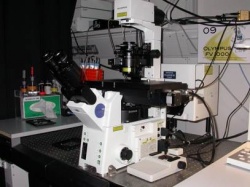CO1 - Olympus Fluoview 1000
From BioDIP
(Difference between revisions)
| Line 13: | Line 13: | ||
|stand=Inverted | |stand=Inverted | ||
|microscope=inverted stand, motorized XY stage, motorized Z-drive, fluorescence, transmitted light with manual DIC | |microscope=inverted stand, motorized XY stage, motorized Z-drive, fluorescence, transmitted light with manual DIC | ||
| − | | | + | |obj1=Olympus UPlanApo 10x 0.4 |
| + | |obj2=Olympus UPlanApo 20x 0.7 | ||
| + | |obj3=Olympus UPlanApo 40x 0.85 | ||
| + | |obj4=Olympus UPlanSApo 40x 1.35 Oil | ||
| + | |obj5=Olympus UPlanSApo 60x 1.35 Oil | ||
| + | |obj6=Olympus UPlanApo 60x 1.2 W | ||
| + | |obj7=- | ||
| + | |obj8=- | ||
|illumination=Halogen<br>HBO<br>405nm diode laser<br>458, 488, 515 ArgonLaser<br>633 nm HeNe laser<br>561 nm Diode laser<br> | |illumination=Halogen<br>HBO<br>405nm diode laser<br>458, 488, 515 ArgonLaser<br>633 nm HeNe laser<br>561 nm Diode laser<br> | ||
|detection=point scanner, 4 confocal [http://en.wikipedia.org/wiki/Photomultiplier PMTs], two independent spectral detection channels, each one configured with a diffraction grating and variable slit for high-resolution wavelength separation and high-speed bandwidth selection, two filter based detection channels, T-PMT, [http://spreadsheets.google.com/pub?key=pMZJXCgd5HNt00W82g1G1TA dichromatic mirrors for excitation/emission splitting], one pinhole | |detection=point scanner, 4 confocal [http://en.wikipedia.org/wiki/Photomultiplier PMTs], two independent spectral detection channels, each one configured with a diffraction grating and variable slit for high-resolution wavelength separation and high-speed bandwidth selection, two filter based detection channels, T-PMT, [http://spreadsheets.google.com/pub?key=pMZJXCgd5HNt00W82g1G1TA dichromatic mirrors for excitation/emission splitting], one pinhole | ||
| Line 24: | Line 31: | ||
|link2=[https://spreadsheets.google.com/pub?key=pMZJXCgd5HNu6qJfppRd3JQ scan-head configuration] | |link2=[https://spreadsheets.google.com/pub?key=pMZJXCgd5HNu6qJfppRd3JQ scan-head configuration] | ||
|inv=- | |inv=- | ||
| − | | | + | |objectives=10x/0.4 UPlanApo<br>20x/0.7 UPlanApo<br>40x/0.85 UPlanApo<br>40x/1.35 UPlanSApo<br>(60x/1.35 Oil UPlanSApo - for repair)<br>60x/1.25 Oil UPlanFl - as a substitute<br>60x/1.2 W UPlanApo |
| − | + | ||
| − | + | ||
| − | + | ||
| − | + | ||
| − | + | ||
| − | + | ||
| − | + | ||
}} | }} | ||
Revision as of 17:07, 3 September 2009

|
Directions
[[image:|150px|text-bottom|right]]
Booking
https://python-srv1.mpi-cbg.de/lmf-ipf/cgi-bin/index.py
Details
| microscope | , Inverted stand, inverted stand, motorized XY stage, motorized Z-drive, fluorescence, transmitted light with manual DIC | ||
| objectives | |||
| illumination |
| ||
| detection | [[detection::point scanner, 4 confocal PMTs, two independent spectral detection channels, each one configured with a diffraction grating and variable slit for high-resolution wavelength separation and high-speed bandwidth selection, two filter based detection channels, T-PMT, dichromatic mirrors for excitation/emission splitting, one pinhole]] | ||
| reflectors | [[reflectors::Filter Cube 1. U-MWU2. BP330-385 BA420 DM400
Filter Cube 2. U-MWB2. BP460-490 BA520IF (High performance interference filter) DM500 | ||
| features | Two independent and fully synchronized laser scanners for simultaneous laser stimulation and observation, laser stimulation can be performed using the imaging laser or a 405nm picosecond Diode laser (PicoQuant), sequential imaging, line scan, point scan, Z stacks, time-series, advanced time-series, Kalman averaging, summarizing, scan zoom and rotation"Two independent and fully synchronized laser scanners for simultaneous laser stimulation and observation, laser stimulation can be performed using the imaging laser or a 405nm picosecond Diode laser (PicoQuant), sequential imaging, line scan, point scan, Z stacks, time-series, advanced time-series, Kalman averaging, summarizing, scan zoom and rotation" cannot be used as a page name in this wiki. | ||
| software | |||
| incubation | stage incubator (T+CO2) | ||
| links |
| ||
| inv.nr. | - |